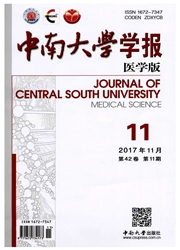

 中文摘要:
中文摘要:
目的:与单剂量气管内滴药模型比较,研究小剂量多次尾静脉注射博莱霉素(bleomycin,BLM)致小鼠肺纤维化的特点与差异。方法:40只雄性ICR(Iastitute for Cancer Research)小鼠随机分为模型组I、模型组II和两个对照组,每组10只。模型组I尾静脉注射10mg/kgBLM均持续14d;模型组II于实验第一天气管内注入5mg/kg BLM,两对照组分别给与等量生理盐水,28aM处死并收集肺泡灌洗液(bronchoalveolar lavage fluid,BALF)。检测BALF细胞总数及蛋白含量、肺系数、羟脯氨酸(hydroxyproline,HYP),观察肺组织病理改变。结果:1)两种给药方法均能使肺组织发生明显的炎性和纤维化反应,两模型组BALF细胞总数及蛋白含量、肺系数、HYP含量、肺间质损伤指数较两对照组均显著增加(P〈0.01);2)模型组I病灶主要分布在胸膜下及血管周围,模型组II则主要分布在支气管和细支气管周围;3)模型组II病死率高于模型组I;4)模型组IIBALF蛋白含量高于模型组I(P〈0.05);BALF细胞总数、肺系数、HYP含量、肺间质损伤指数两组间差异无统计学意义(p〉0.05)。结论:小剂量多次尾静脉注射与气管内滴入BLM都能成功制备肺间质纤维化动物模型,但两者纤维化形成的部位存在着一定的差异,小剂量多次尾静脉给药肺间质纤维化模型更接近特发性肺间质纤维化。
 英文摘要:
英文摘要:
Objective:To determine the characteristics and differences in bleomycin-induced lung fibrosis model by repeated low-dose intravenous injection and single dose intratracheal instillation of bleomycin. Methods: Forty male ICR (Institute for Cancer Research) mice were randomly divided into a model group I, a model group II, and 2 control groups (10 mice in each group). In model group I, bleomycin was injected intravenously at 10 mg/(kg.d) for 14 consecutive days; and in model group II, bleomycin was instilled intratracheally at 5 mg/kg. The 2 control groups were given isotonic saline solution. At the 28th day, the mice were sacrificed and the bronchoalveolar lavage fluid (BALF) was collected. The total cells and proteins in the BALF, pulmonary coefficient, and hydroxyproline (HYP) content were determined, The pathological changes were observed by the eosin staining and Masson's trichrome staining. Results: 1) Both intravenous injection and intratracheal instillation ofbleomycin resulted in severe and extensive inflammation and fibrosis in the lungs. The total cells and proteins in the BALF, HYP content, pulmonary coefficient and the pathological score of pulmonary fibrosis were all significantly increased in the 2 model groups (P〈0.01). 2) Fibrosis was mainly under the pleura or around the vessel in model group I, and it was located near the bronehia and bronchioles in model group II. 3) The death rate was higher in the model group II than that in the model group I. 4) Proteins in the BALF were significantly higher in model group II than that in model group I (P〈0.05). ~-here was no difference in the total cells in the BALF, the pulmonary coefficient, the HYP content, and the pathological score of pulmonary fibrosis between the 2 groups (P〉0.05). Conclusion: The pulmonary fibrosis model can be successfully established by intravenous injection or intratracheal instillation of bleomycin, but the sites of pulmonary fibrosis are different. The histological changes
 同期刊论文项目
同期刊论文项目
 同项目期刊论文
同项目期刊论文
 期刊信息
期刊信息
